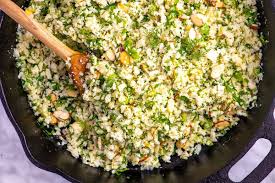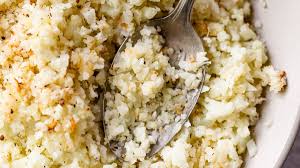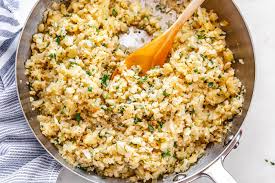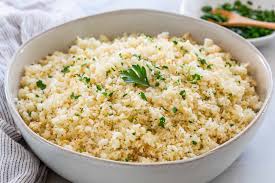Table of Contents
ToggleCauliflower rice has become a sensation in the culinary world, gaining popularity as a healthy and versatile alternative to traditional rice. This low-carb option has captured the attention of health enthusiasts, fitness experts, and culinary innovators. As more people seek nutrient-dense and low-calorie meal options, cauliflower continues to stand out for its numerous benefits and culinary possibilities.
The Nutritional Benefits of Cauliflower Rice

Cauliflower rice offers an impressive nutritional profile that appeals to health-conscious individuals. It is rich in vitamins, minerals, and antioxidants while being low in calories and carbohydrates. A typical serving of cauliflower contains high amounts of vitamin C, which boosts the immune system and supports skin health. Additionally, it provides a good dose of vitamin K, essential for bone health and blood clotting.
This alternative to rice is also an excellent source of dietary fiber, aiding digestion and promoting gut health. With its low glycemic index, cauliflower rice is particularly beneficial for those managing diabetes or seeking to stabilize their blood sugar levels. The vegetable also contains antioxidants like glucosinolates and isothiocyanates, which may help reduce inflammation and protect against certain diseases.
Why Cauliflower Rice is a Popular Low-Carb Option
One of the main reasons cauliflower rice has surged in popularity is its suitability for low-carb diets. Traditional rice, whether white or brown, is carbohydrate-heavy and may not fit into ketogenic, paleo, or other low-carb meal plans. Cauliflower offers a satisfying, grain-like texture without the carb load, making it ideal for those looking to reduce carbohydrate intake while still enjoying a rice substitute.
Moreover, cauliflower rice is gluten-free, catering to individuals with gluten intolerance or those following a gluten-free lifestyle. Its neutral flavor allows it to be a perfect base for a wide range of dishes, from savory stir-fries to hearty casseroles.
Preparing Cauliflower Rice at Home
Making cauliflower rice at home is a straightforward process that requires minimal equipment and effort. Fresh cauliflower is the primary ingredient, and the preparation steps are simple:
- Start by removing the leaves and stem from the cauliflower head.
- Cut the cauliflower into smaller florets for easier handling.
- Use a food processor to pulse the florets until they reach a rice-like consistency. Alternatively, a box grater can be used for the same effect.
Once prepared, the cauliflower can be stored in an airtight container in the refrigerator for up to three days or frozen for longer storage. Cooking the rice is equally simple and requires just a few minutes of sautéing in a pan with a bit of oil or butter.
Versatility in Culinary Applications
The adaptability of cauliflower rice makes it a staple in many kitchens. Its versatility allows it to complement an array of dishes and cuisines. It can be used as a direct replacement for traditional rice in recipes like fried rice, risotto, and pilafs. Additionally, it serves as an excellent base for grain-free sushi or burrito bowls.
Cauliflower is not limited to savory applications; it can also be transformed into creative desserts. By incorporating spices like cinnamon and nutmeg, along with a sweetener, it can be turned into a healthier alternative to rice pudding.
The Role of Cauliflower Rice in Weight Management

For individuals aiming to lose or maintain weight, cauliflower rice is an excellent addition to their diet. With significantly fewer calories and carbs than regular rice, it allows for larger portion sizes without exceeding caloric limits. The high fiber content in cauliflower also promotes satiety, helping individuals feel fuller for longer and reducing the likelihood of overeating.
Its low-calorie nature makes it an ideal choice for meal prepping, as it can be incorporated into balanced meals without compromising dietary goals.
Environmental Benefits of Choosing Cauliflower Rice
In addition to its health advantages, cauliflower rice offers environmental benefits. Cauliflower requires less water and fewer resources to grow compared to traditional rice. This makes it a more sustainable choice for those looking to reduce their environmental footprint. By choosing cauliflower, individuals can support a more eco-friendly food system while enjoying a nutritious meal.
Store-Bought vs. Homemade Cauliflower Rice
While making cauliflower rice at home is cost-effective and allows for greater control over freshness, store-bought options have become increasingly available. Pre-packaged cauliflower rice can be found in the frozen or fresh produce sections of most supermarkets. These options provide convenience for those with busy schedules or limited time to cook.
However, it is essential to check labels when purchasing store-bought cauliflower, as some varieties may contain added preservatives or seasonings that increase sodium content. Opting for plain, unseasoned options ensures a healthier choice.
Tips for Enhancing the Flavor of Cauliflower Rice

While cauliflower rice has a mild flavor, there are numerous ways to enhance its taste and make it more appealing. Adding aromatic ingredients like garlic, onions, and herbs can elevate the dish. Incorporating spices such as turmeric, cumin, or paprika can also add depth and color.
For a richer flavor, consider cooking cauliflower rice in broth instead of water or adding a splash of coconut milk for a creamy texture. Pairing it with flavorful sauces or toppings further enhances its taste, making it a favorite among even the pickiest eaters.
Addressing Common Misconceptions
Despite its growing popularity, some misconceptions mariatogel about cauliflower rice persist. One common myth is that it cannot replicate the texture or taste of traditional rice. While it is true that cauliflower has a unique texture, its adaptability and ability to absorb flavors make it a worthy substitute in most recipes.
Another misconception is that cauliflower rice is only suitable for weight loss or low-carb diets. On the contrary, it is a nutritious option for anyone looking to diversify their meals and incorporate more vegetables into their diet.
The Future of Cauliflower Rice
As the demand for healthier and more sustainable food options continues to rise, cauliflower rice is poised to remain a favorite among consumers. Food manufacturers and chefs are constantly innovating, creating new products and recipes that incorporate this versatile ingredient. From pre-seasoned varieties to ready-to-eat meals, the possibilities are endless.
Moreover, with increasing awareness about the benefits of plant-based diets, cauliflower serves as an excellent example of how vegetables can replace traditional staples without sacrificing flavor or satisfaction.
Conclusion
Cauliflower rice is more than just a trend; it represents a shift toward healthier and more sustainable eating habits. Its nutritional benefits, culinary versatility, and environmental advantages make it a valuable addition to any diet. Whether made at home or purchased from a store, cauliflower rice offers endless possibilities for creating delicious and nutritious meals. By embracing this innovative ingredient, individuals can enjoy the best of both worlds: great taste and improved health.

